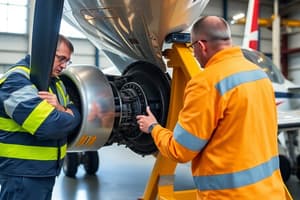Podcast
Questions and Answers
What is the primary focus of EASA regarding Human Factors?
What is the primary focus of EASA regarding Human Factors?
- Crew resource management training
- Fatigue management and ergonomics (correct)
- Pilot psychological assessment
- Cockpit design regulations
Which step in the Aircraft Design Process involves defining the aircraft's state and flight characteristics?
Which step in the Aircraft Design Process involves defining the aircraft's state and flight characteristics?
- Conceptual Design
- Mission Definition (correct)
- Detailed Design
- Preliminary Design
Which organization focuses on workplace safety and ergonomics in high-risk environments?
Which organization focuses on workplace safety and ergonomics in high-risk environments?
- ISO 9241
- OSHA (correct)
- EASA
- FAA
During which phase of the Aircraft Design Process are the design elements finalized?
During which phase of the Aircraft Design Process are the design elements finalized?
What does ISO 9241 specifically address?
What does ISO 9241 specifically address?
Which stage of the Aircraft Design Process includes optimizing the conceptual design?
Which stage of the Aircraft Design Process includes optimizing the conceptual design?
What is a key characteristic of the Human Factors standards established by the FAA?
What is a key characteristic of the Human Factors standards established by the FAA?
In the Aircraft Design Process, what is produced during the Conceptual Design phase?
In the Aircraft Design Process, what is produced during the Conceptual Design phase?
What contributes to the occurrence of illusions in the vestibular system during flight?
What contributes to the occurrence of illusions in the vestibular system during flight?
Which component of spatial cognition involves understanding an aircraft's position relative to various hazards?
Which component of spatial cognition involves understanding an aircraft's position relative to various hazards?
What type of frame of reference uses the pilot's own body coordinates?
What type of frame of reference uses the pilot's own body coordinates?
Which type of display is considered ideal for maintaining accurate flight paths?
Which type of display is considered ideal for maintaining accurate flight paths?
What is a key characteristic of rule-based decisions in aviation?
What is a key characteristic of rule-based decisions in aviation?
Which aspect of situational awareness involves projecting the status of elements in the environment into the future?
Which aspect of situational awareness involves projecting the status of elements in the environment into the future?
What is the purpose of maps in pilot navigation?
What is the purpose of maps in pilot navigation?
Which type of decisions in aerospace is informed primarily by training and past experiences?
Which type of decisions in aerospace is informed primarily by training and past experiences?
What is the primary function of attention in the context of aerospace?
What is the primary function of attention in the context of aerospace?
Which type of attention involves focusing on multiple tasks at the same time?
Which type of attention involves focusing on multiple tasks at the same time?
What challenge can lead to decreased attention and increased errors in judgment for aerospace professionals?
What challenge can lead to decreased attention and increased errors in judgment for aerospace professionals?
Which scenario represents a case of sustained attention in aviation?
Which scenario represents a case of sustained attention in aviation?
What can result from automation-induced complacency in cockpit operations?
What can result from automation-induced complacency in cockpit operations?
Which of the following best describes selective attention?
Which of the following best describes selective attention?
Which factor is most likely to affect sustained attention in aerospace environments?
Which factor is most likely to affect sustained attention in aerospace environments?
What can cognitive overload in aerospace lead to?
What can cognitive overload in aerospace lead to?
What environmental factor is shown to notably decline attention due to distractions?
What environmental factor is shown to notably decline attention due to distractions?
What is the primary impact of engaging in monotonous tasks?
What is the primary impact of engaging in monotonous tasks?
After how long does vigilance typically begin to significantly decline during a task?
After how long does vigilance typically begin to significantly decline during a task?
Which of the following is NOT a characteristic of circadian rhythms?
Which of the following is NOT a characteristic of circadian rhythms?
What is the result of prolonged engagement in vigilance tasks?
What is the result of prolonged engagement in vigilance tasks?
Which statement best describes the impact of environmental conditions on cognitive performance?
Which statement best describes the impact of environmental conditions on cognitive performance?
What does research indicate about tasks with low variation?
What does research indicate about tasks with low variation?
Which of the following is a crucial function of circadian rhythms?
Which of the following is a crucial function of circadian rhythms?
What is the primary function of visual perception for pilots?
What is the primary function of visual perception for pilots?
Which of the following factors can impair visual perception in aerospace?
Which of the following factors can impair visual perception in aerospace?
What type of perception allows pilots to judge their altitude and proximity to terrain?
What type of perception allows pilots to judge their altitude and proximity to terrain?
What challenge is associated with auditory perception in the cockpit?
What challenge is associated with auditory perception in the cockpit?
Which type of perception is necessary for interpreting sounds like alarms and engine noise?
Which type of perception is necessary for interpreting sounds like alarms and engine noise?
What can cause spatial disorientation in pilots?
What can cause spatial disorientation in pilots?
How do visual illusions in aviation occur?
How do visual illusions in aviation occur?
What is a key application of auditory perception for pilots?
What is a key application of auditory perception for pilots?
Flashcards are hidden until you start studying
Study Notes
Human Factors in Aviation
- FAA (Federal Aviation Administration): Establishes standards for human factors in cockpit design, pilot training, and CRM (Crew Resource Management).
- EASA (European Union Aviation Safety Agency): Regulates human factors in European aviation, emphasizing ergonomics, fatigue management, and safety systems.
- ISO 9241: International standard for ergonomics in human-computer interaction widely used in aviation.
- OSHA (Occupational Safety and Health Administration): Enforces regulations addressing human factors in workplace safety, focusing on ergonomics and reducing human errors.
Aircraft Design Process
- Mission Definition: Defines the aircraft state and flight characteristics, establishing design requirements.
- Conceptual Design: Focuses on achieving mission definition requirements through rough sketches and conceptualizing features like wing location and engine size.
- Preliminary Design: Optimizes the conceptual design, using models for further testing and refinements.
- Detailed Design: Finalizes the aircraft design, specifying all design elements and quantities.
Spatial Cognition in Aviation
- Definition: Understanding the position and movement of objects in space relative to oneself.
- Importance: Crucial for pilots to maintain situational awareness, navigate effectively, and avoid hazards.
- Components:
- Mental Representation: Pilots form internal representations of the aircraft's spatial properties (e.g., bank and airspeed).
- Geographical Awareness: Recognizing the aircraft's position relative to destinations and potential hazards (e.g., terrain, weather, traffic).
Frames of Reference in Spatial Cognition
- Egocentric: Reference point is the pilot's body coordinates (e.g., left-right, up-down).
- Exocentric: External frame of reference showing airspace relative to the aircraft.
Maps in Spatial Navigation
- Support for Pilot Navigation: Paper or electronic maps provide essential navigational support.
- Frame-of-Reference Considerations: Navigate between 2D and 3D maps, understand rotating maps, and manage clutter in electronic displays.
Spatial Awareness and Flight Displays
- Fully Egocentric Displays: Ideal for maintaining accurate flight paths by replicating control-display compatibility.
- Exocentric Displays: Offer broader awareness of airspace, particularly for terrain, traffic, and weather monitoring.
Decision-Making in Aerospace
- Decision-making in aerospace: Choosing suitable actions in real-time, often under pressure.
- Decision-making types:
- Rule-based decisions: Following established procedures.
- Skill-based decisions: Automatic responses based on experience and training.
- Knowledge-based decisions: Using knowledge and reasoning to solve unique problems.
Situational Awareness in Aerospace
- Definition: Perceiving environmental elements, understanding their meaning, and projecting future status.
- Importance: Crucial for flight safety, automation development, and training.
Attention and Perception in Situational Awareness
- Attention: Selectively focusing on particular information or tasks while ignoring others.
- Types of Attention:
- Selective Attention: Concentrating on specific stimuli while ignoring irrelevant information.
- Divided Attention: Focusing on and processing multiple information sources or tasks simultaneously.
- Sustained Attention (Vigilance): Maintaining prolonged focus on tasks over extended periods.
- Challenges to Maintaining Attention:
- Cognitive Overload: Processing excessive information.
- Stress and Fatigue: Reduced attention due to stress or fatigue.
- Automation-Induced Complacency: Reduced attention due to relying on automation.
- Perception: Interpreting sensory input to create meaningful representations of the environment.
- Types of Perception:
- Visual Perception: Processing visual information from the environment and flight instruments.
- Auditory Perception: Processing sounds like radio communications, alarms, and engine noise.
- Spatial Perception: Perceiving position, movement, and orientation of oneself or objects.
- Challenges to Perception:
- Visual Illusions: Environmental factors creating misleading perceptions.
- Spatial Disorientation: Losing a sense of the aircraft's position relative to the ground.
Factors Affecting Cognitive Processes in Aviation
- Environmental Factors: External conditions like noise, lighting, temperature, and workspace design influencing cognitive performance.
- Monotony and Repetition: Repetitive tasks leading to cognitive fatigue and disengagement.
- Duration of Vigilance Task: Vigilance typically decreases over time, with significant decline after approximately 30 minutes.
Circadian Rhythms
- Definition: 24-hour cycles that regulate bodily functions and processes.
- Importance: Help living organisms respond to environmental changes.
- Examples: Sleep-wake cycle, hormone release, and temperature regulation.
Studying That Suits You
Use AI to generate personalized quizzes and flashcards to suit your learning preferences.




